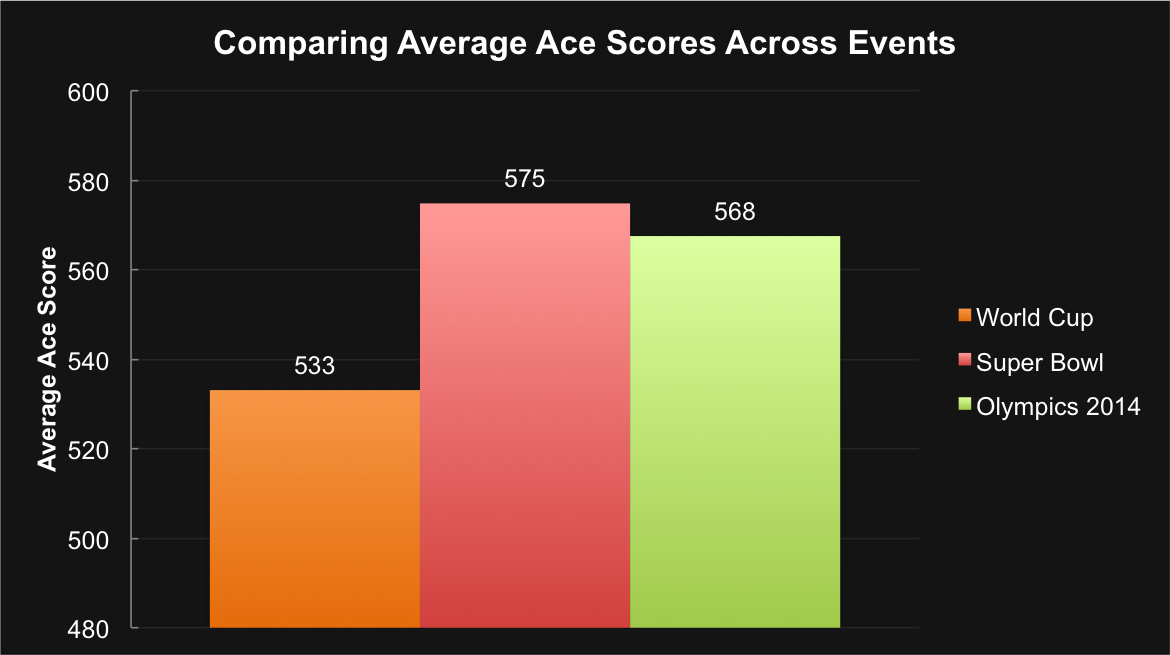In World Cup advertising, like in the game of soccer itself, it helps to pick your spots.
Looking at data across 50 ads thus far this World Cup cycle we find that the effectiveness of the advertising is highly dependent on your passion for the game. Those that plan to watch at least one World Cup match scored the ads 57% higher than those who don’t plan to watch the World Cup at all (although with the US team’s performance, this World Cup may be bringing some new fans to the fold…). While fans score the ads significantly higher, there simply are not that many of them. Twenty years after the event was held in the US, only about half of the respondents to our surveys considered themselves to be a fan (meaning they planned to watch at least one game) and the passionate fans (those that planned on watching more than five games) represented only a third of our sample. This presents a challenge for World Cup advertisers, both sponsors and non-sponsors alike, as the performance of that advertising declines significantly when presented to a broader population of Americans.
As a result, World Cup ads trail the 90-day norm for advertising (around 2,000 ads worth of data with an Ace Score norm of 567) by about 6%. This stands in contrast to the Olympics or the Super Bowl, where ads debuting or running during those events scored 7% and 3%, respectively, above the standard ad. Similar to the Olympics, the “bandwagon” advertisers, those that are not official FIFA World Cup sponsors, outnumber the select few brands that are sponsors by 3-1. This gives rise to some compelling creative associations from everyone from Beats to Volkswagen.

The top overall ad with a World Cup tie-in goes to Kia with its “Close Call” ad. It’s a bit of a ringer, however, as Kia simply added the FIFA tag to the end of a successful ad from December of 2013. Surprisingly, this is the only ad from an official sponsor to make our top ten list.
Other top performing creative includes Clorox brand Glad. The ad showcases the strength of its Forceflex trash bag with a young boy soccer-kicking the bag out to the garbage truck (Ace Score: 636).
Procter and Gamble brand Crest also delivers a winner with its ad “The Further Your Team Goes” (Ace Score: 612). This ad humorously creates a tie between the toothpaste product and the disappearance of personal space when your team scores.
McDonald’s is having a strong World Cup with several ads scoring with soccer fans including “Gol!” and “World Cup Basketball.”
The most prolific advertiser in the World Cup is a surprise. Beats Audio followed up on its athlete driven NFL playoff campaign with more footballers – these of the international variety. Its “Game Before the Game” athlete montages (there are six) struggled to reach the audience, however, delivering an average Ace Score of 482. They improve with the true fan (intend to watch more than 10 games) but still don’t break the top 10.
Gender plays a role in advertising effectiveness as well. World Cups ads underperform standard ads with men by nearly 2%. Women, however, dramatically under-perform standard ads by close to 8%.
We still expect to see some new creative as we leave the group stage and into the knockout round – but the data suggests that when the World Cup ends, so will some of the opportunities for these ads.